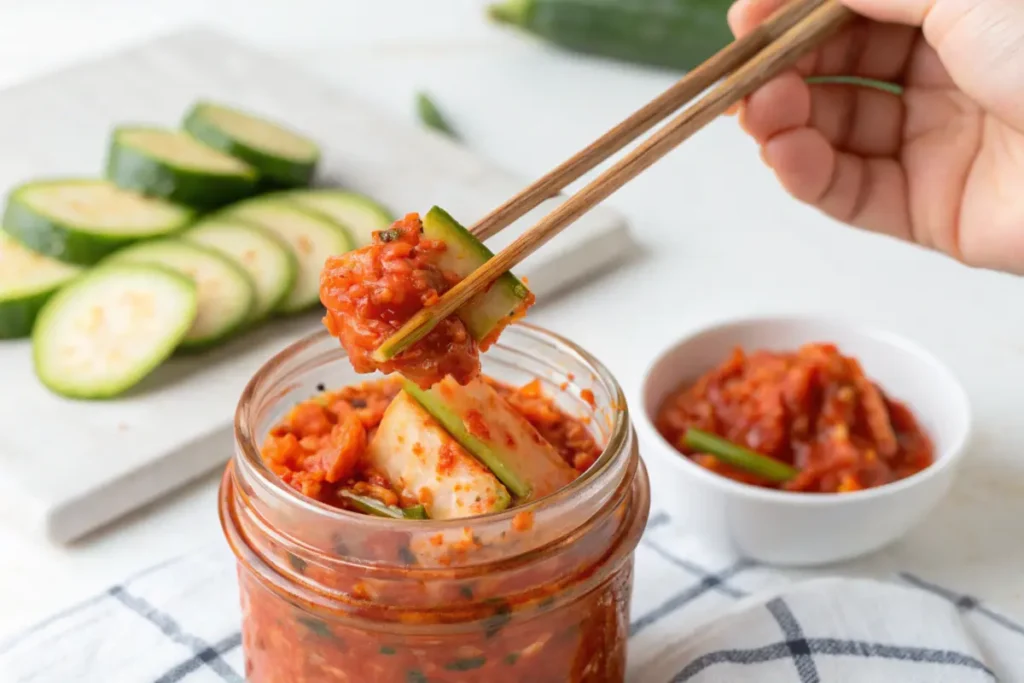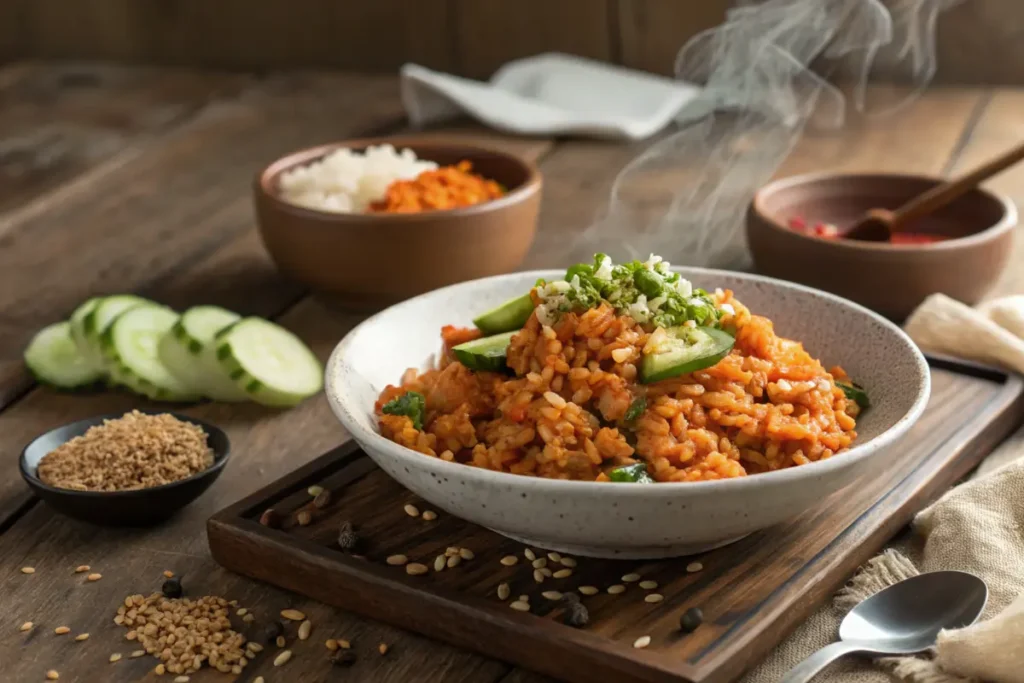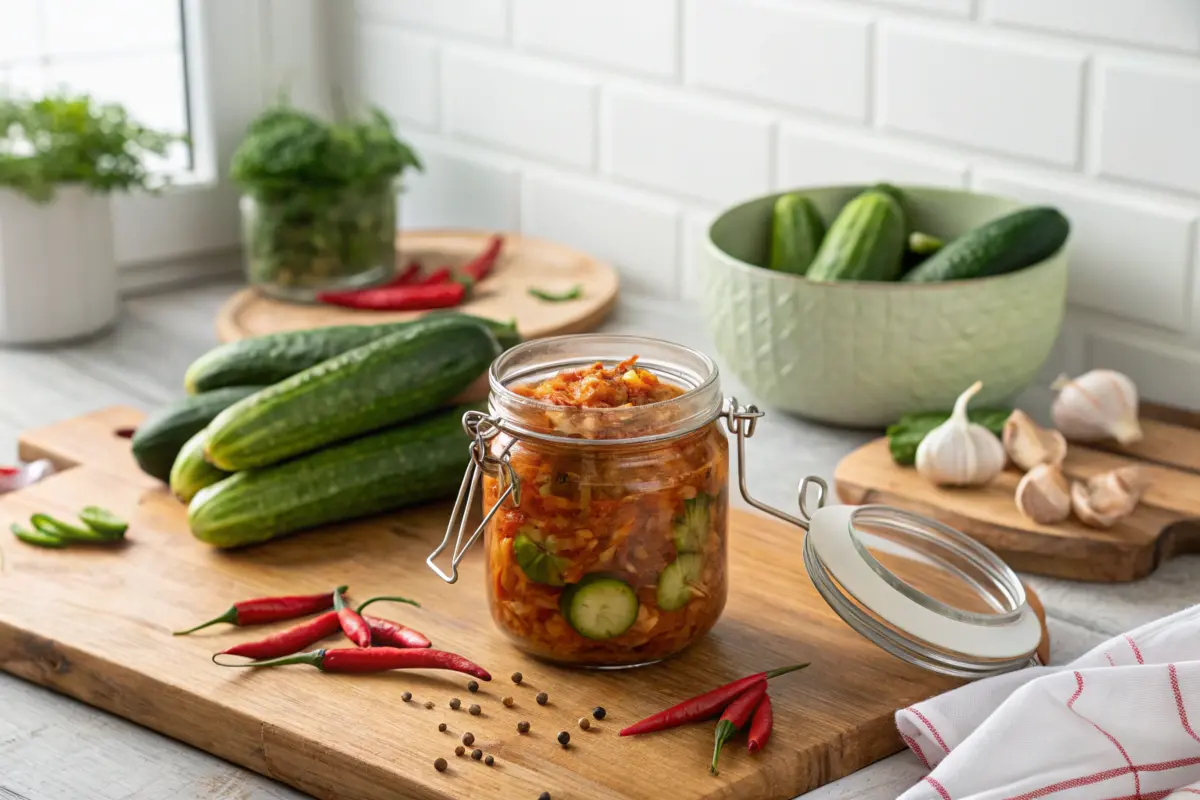Kimchi is a beloved staple of Korean cuisine, and cucumber kimchi holds a special place for its crisp, refreshing texture and zesty flavor. But how long can this delightful side dish last? While it’s easy to fall for its tangy charm, proper storage and understanding its shelf life are crucial for both taste and safety. In this article, we’ll uncover the factors that affect cucumber kimchi’s longevity, explore signs of spoilage, and share tips for preserving it for as long as possible. Let’s dive in!
Understanding Cucumber Kimchi and Its Shelf Life
What is Cucumber Kimchi?
Cucumber kimchi, known as oi sobagi in Korean, is a type of fermented side dish made by pickling fresh cucumbers with a spicy, savory seasoning blend. It’s a quick-fermentation kimchi, meaning it’s ready to eat within a short time compared to its cabbage counterpart. The dish boasts a crisp texture and a punchy flavor from ingredients like garlic, gochugaru (Korean chili powder), and fish sauce. Unlike traditional kimchi, cucumber kimchi is typically served fresh, making it a favorite for its light, refreshing taste.
Why Does Cucumber Kimchi Have a Limited Shelf Life?
Every bite of cucumber kimchi is a product of fermentation, a natural process where beneficial bacteria convert sugars into lactic acid. This acid not only gives the kimchi its signature tang but also acts as a preservative. However, cucumber kimchi’s shelf life is shorter than other types because cucumbers have high water content, which speeds up spoilage. Over time, the cucumbers lose their crunch, and the kimchi becomes overly sour—signaling it’s past its prime.
Key factors that influence how long cucumber kimchi lasts include:
- Salt levels: Higher salt content slows fermentation and prolongs freshness.
- Temperature: Cooler storage significantly delays spoilage.
- Airtight containers: Limiting air exposure prevents unwanted bacteria from invading.
Factors That Affect the Longevity of Cucumber Kimchi
Impact of Fermentation Time on Shelf Life
The fermentation process is the heart of kimchi-making and significantly determines how long cucumber kimchi lasts. Early fermentation, often between 1 to 3 days, results in a fresher, crunchier taste. However, the longer fermentation continues, the tangier and softer the kimchi becomes. While some enthusiasts enjoy the bold flavors of well-aged cucumber kimchi, over-fermentation may compromise its quality, leaving it overly sour and mushy.
To enjoy cucumber kimchi at its peak, consider these tips:
- Monitor taste daily during early fermentation to catch it at your preferred flavor.
- Store in the refrigerator immediately after achieving the desired fermentation level to slow further changes.
Role of Storage Conditions
Proper storage can make or break the shelf life of cucumber kimchi. Refrigeration is essential, as temperatures between 32°F and 39°F (0°C to 4°C) slow down the growth of bacteria and maintain its crunchiness. Avoid placing the container near the refrigerator door, where temperature fluctuations are common.
Additionally, using airtight containers minimizes oxygen exposure, preventing harmful bacteria from spoiling the kimchi. For smaller portions, dividing the kimchi into individual containers reduces the frequency of opening the main jar, helping it last longer.
Influence of Ingredients
The freshness and quality of ingredients directly impact cucumber kimchi’s longevity. Firm, blemish-free cucumbers provide the best base for this dish. Moreover, the seasoning plays a role—ingredients like gochugaru and garlic have antimicrobial properties that naturally extend shelf life. Adjusting salt levels can also influence how long the kimchi stays edible, as higher salt content slows fermentation.
Signs That Cucumber Kimchi Has Gone Bad

Visual Indicators
Your eyes are one of the best tools for determining if cucumber kimchi is past its prime. Fresh kimchi should have a vibrant color and crisp appearance. If you notice a dull or darkened color, visible mold, or slimy textures, it’s time to discard it. Mold on the surface is particularly concerning, as it indicates contamination.
Smell and Texture
Fermentation gives cucumber kimchi its distinctive tangy aroma, but a foul, overly sour, or ammonia-like smell can signal spoilage. Similarly, while the cucumbers naturally soften over time, excessively mushy or slimy textures are clear warning signs.
Taste Test
Taste should be your last test. While aged kimchi develops a stronger flavor, an overwhelmingly sour or bitter taste indicates it’s no longer safe to eat. Trust your senses—if something seems off, err on the side of caution and discard it.
For those interested in perfecting their cucumber kimchi-making skills, check out this helpful guide to preparing cucumber kimchi. It’s packed with insights to help you enjoy this beloved dish at its best!
How to Properly Store Cucumber Kimchi
Refrigeration Tips
Storing cucumber kimchi in the refrigerator is non-negotiable if you want it to last. The cold environment slows down the fermentation process, preserving the tangy taste and crisp texture. Place your kimchi in an airtight container to minimize air exposure, which can lead to spoilage. Always store it in the coldest part of the fridge—typically the back or lower shelves—to maintain a steady temperature.
Using smaller containers can be a smart strategy. By dividing your cucumber kimchi into portions, you reduce the frequency of opening a single container, which prevents contamination and helps it last longer.
Can You Freeze Cucumber Kimchi?
Freezing cucumber kimchi can extend its shelf life by months, but the process has its drawbacks. Freezing changes the texture, often making cucumbers softer upon thawing. However, the flavor usually remains intact, making it a great option for cooking or as an ingredient in recipes where texture matters less.
Here’s how to freeze cucumber kimchi properly:
- Pack it tightly into a freezer-safe, airtight container.
- Leave about an inch of space at the top to allow for expansion.
- Label and date the container before freezing.
- Thaw in the refrigerator when ready to use.
It’s best to use frozen cucumber kimchi within 3–6 months for optimal flavor and safety.
Prolonging the Shelf Life of Cucumber Kimchi
Hygiene Practices During Preparation
Proper hygiene is a cornerstone of extending how long cucumber kimchi lasts. Always start with clean hands, sterilized containers, and utensils. This minimizes the introduction of harmful bacteria, which can spoil your kimchi prematurely. Avoid double-dipping into the container and always use clean tools when serving.
Modifications to the Recipe
If you’re keen on maximizing the lifespan of your cucumber kimchi, consider these recipe adjustments:
- Add extra salt: Salt acts as a natural preservative, slowing fermentation.
- Use more gochugaru: The chili powder’s antimicrobial properties help ward off spoilage.
- Incorporate vinegar: A splash of vinegar enhances tanginess while extending freshness.
For more ideas on how to work with fermented foods, check out the recipe section on Recipe Foodies for inspiration on incorporating kimchi into delicious meals.
Frequently Asked Questions About Cucumber Kimchi
How Long Does Cucumber Kimchi Last in the Refrigerator?
When stored correctly, cucumber kimchi can last 1–3 months in the refrigerator. However, the flavor and texture evolve as it ages, with the dish becoming tangier and softer over time. For the best taste, many recommend enjoying it within the first two weeks.
Can Cucumber Kimchi Go Bad?
Yes, like any food, cucumber kimchi can spoil. Signs of spoilage include an overly sour or rotten smell, a slimy texture, or visible mold. If you notice any of these changes, it’s best to discard the kimchi to avoid health risks.
How Can I Tell If My Kimchi Is Still Safe to Eat?
A fresh batch of cucumber kimchi will have a vibrant color, tangy aroma, and crisp texture. As it ages, the tanginess will intensify, which is normal. However, if the smell is off-putting, the texture is mushy, or mold is present, it’s time to throw it out.
Is It Safe to Eat Expired Cucumber Kimchi?
Kimchi doesn’t typically have an expiration date but instead a “best by” date. If properly stored and showing no signs of spoilage, older kimchi is usually safe to eat. That said, its taste and texture may not be as appealing. Always rely on your senses to assess safety.
Wrapping Up – Ensuring Your Kimchi Lasts Longer
Key Takeaways for Storing and Enjoying Cucumber Kimchi
Understanding how long cucumber kimchi lasts is essential to fully enjoying this flavorful dish. Proper storage, such as refrigeration and using airtight containers, is crucial. By monitoring its appearance, smell, and texture, you can ensure your kimchi is safe to eat while savoring its evolving flavors.
A Quick Note on Incorporating Kimchi Into Your Diet
Whether you enjoy it as a side dish, in soups, or as a topping, cucumber kimchi is versatile and packed with probiotics. If you’re interested in experimenting with recipes, browse the Recipe Foodies website for creative ways to use kimchi in your meals.
Common Mistakes That Shorten the Shelf Life of Cucumber Kimchi
Using Non-Airtight Containers
One of the most common mistakes people make is storing cucumber kimchi in containers that aren’t airtight. When air enters the container, it promotes the growth of unwanted bacteria, causing the kimchi to spoil faster. Always ensure the lid is tightly sealed to maximize freshness.
Storing at Improper Temperatures
Refrigeration is key to extending how long cucumber kimchi lasts. Storing kimchi in warmer areas, like the refrigerator door or on the counter, accelerates fermentation and spoilage. To maintain its crispness and tang, keep your kimchi in the coldest part of the fridge, such as the back or bottom shelf.
Cross-Contamination During Serving
Using dirty utensils or allowing crumbs and other food particles to enter the kimchi jar can introduce harmful bacteria. This contamination not only affects the current batch but can spoil the entire jar. Always use clean utensils and avoid double-dipping.
Creative Ways to Use Leftover or Aged Cucumber Kimchi

Transforming Aged Kimchi Into New Dishes
If your cucumber kimchi has become too tangy for fresh eating, don’t toss it! Instead, incorporate it into recipes where the bold flavors shine. Aged kimchi works wonderfully in:
- Kimchi Fried Rice: Its tangy kick elevates this quick, satisfying dish.
- Soups and Stews: Add depth to broths and hot pots by tossing in your kimchi.
- Toppings for Sandwiches and Burgers: Balance the richness with a spicy, tangy bite.
Pairing Fresh Kimchi with Different Meals
Fresh cucumber kimchi is incredibly versatile. Serve it as a side dish to grilled meats, mix it into salads, or use it as a topping for rice bowls. Its refreshing flavor and crunch can enhance almost any meal, making it a must-have for creative cooks.
Conclusion
Cucumber kimchi is a delightful blend of flavors and textures that can enhance any meal, but understanding how long cucumber kimchi lasts is essential for both safety and enjoyment. Proper storage, clean preparation, and mindful consumption are key to preserving its freshness and probiotic benefits.
From crisp, fresh batches to well-aged, tangy versions, cucumber kimchi offers a spectrum of flavors to suit every palate. Even if it becomes overly fermented, creative recipes can help you transform it into exciting new dishes, reducing waste and adding variety to your meals.
By following the tips in this guide, you can maximize the shelf life of your cucumber kimchi, avoid common mistakes, and explore its versatility. Whether you’re a longtime kimchi lover or new to the dish, this vibrant Korean classic is sure to bring a flavorful twist to your table. Enjoy!

